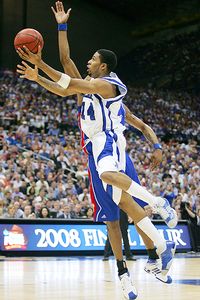
By Andy Katz
ESPN.com
(Archive)
NEW YORK -- When will the underclassmen learn that the NBA draft can be a cruel and unforgiving process?
Mississippi State junior Jamont Gordon and USC freshman Davon Jefferson got a tough lesson Thursday. After leaving school early, both failed to be selected in the NBA draft. They flushed away their college eligibility, they lost their amateur status and now they'll be trying to make a team as a free agent.
Last month, Gordon chose to turn down an invitation to the Orlando pre-draft camp. The word was that he thought he would go in the first round.
Jefferson went to Orlando and at the time said he felt he was ready to make the jump to the NBA.
Both players better hope they get to the D-League and somehow make the NBA the hard way.
Even though a record 10 freshmen were selected in the first round, there were a number of disappointed underclassmen Thursday night. Clearly, a handful of early entrants got poor advice about their draft status, stayed in the draft instead of returning to school and plummeted below expectations.
Texas A&M's DeAndre Jordan left the Aggies after one season to go in the second round, No. 35 overall, to the L.A. Clippers. Jordan might have a shot to get a guaranteed contract, but clearly he didn't leave college for a second-round selection. He is a work in progress, but there was a theory that the work would be done as a first-round guaranteed selection.
Those close to Jordan during this NBA draft process raved about his raw talent, but the Aggies' staff had reasons for not playing him much toward the end of the season. They weren't enamored with his overall skill set, and that's why he'll have to earn his way in the NBA as a second-round pick.
New Jersey might have a steal in Memphis junior guard Chris Douglas-Roberts. But it still must have been a hard landing for CDR to go to No. 40.
Alabama junior Richard Hendrix, BYU junior Trent Plaisted and Kansas State freshman Bill Walker can't complain about going in the second round. Hendrix and Plaisted knew they likely had no shot to go in the first round when they decided to stay in the draft. Walker had to know that once he injured his knee -- again -- and decided to stay in the draft that he was likely going to go in the second round. There was some hope that he could go in the first, but that seemed to be less realistic as the night progressed.
Hendrix went to Golden State at No. 49. Plaisted went to Detroit (after Seattle traded the rights) at No. 46. Walker got dealt to Boston after getting selected by Washington at No. 47.
Kansas sophomore Darrell Arthur must be exhausted since he didn't get selected until No. 27 by New Orleans, which had already sold his rights to Portland. Arthur was then moved to Houston and eventually to Memphis.
Arthur was once projected as a lottery pick but might have dropped in the draft due to concerns over a reported blood test that showed a potential kidney issue. After he was picked late in the first round, he was traded for Donte Greene at the end of the night.
Greene, the Syracuse freshman, stayed in the draft because he assumed that he would go close to the lottery, if not in the lottery. Greene went No. 28 to Memphis but then ended the evening in Houston.

Ronald Martinez/Getty Images
Chris Douglas-Roberts left Memphis early only to fall to the middle of the second round, where he won't have a guaranteed contract.
The big winners of the disappointed underclassmen actually might be Kansas junior Mario Chalmers and UCLA junior forward Luc Richard Mbah a Moute.
Chalmers didn't get selected until No. 34 by Minnesota, but he was dealt to Miami for two future second-round picks. This is great news for Chalmers since he is going to a team that coveted a point guard late in the first round. The Heat couldn't get another pick, and once they selected forward Michael Beasley with the second overall pick, they needed to get a point guard. Chalmers can be the answer as a potential backcourt mate for Dwyane Wade. Chalmers will likely have the best shot of any of these second-round picks to get a guaranteed contract.
Mbah a Moute knew he was a long shot for the first round, but he went to a team in Milwaukee at No. 37 that had interest in him for his defense and rebounding. Mbah a Moute will have a shot to make the Bucks.
While a number of underclassmen fell in the draft, Cal sophomore Ryan Anderson went to New Jersey at No. 21, higher than projected. Anderson took a gamble by staying in the draft, and it paid off handsomely for him. Florida sophomore Marreese Speights got a good situation when he went at No. 16 to Philadelphia. Nevada sophomore JaVale McGee (No. 18 to Washington), NC State freshman J.J. Hickson (No. 19 to Cleveland) and Ohio State freshman Kosta Koufos (No. 23 to Utah) were essentially picked in the range they were projected.
Still, the overriding question is whether there be lessons learned from Jefferson and Gordon. Will anyone ever pay attention to how far some of these projected lottery picks slid?
The sad truth is that a year from now, in the 2009 NBA draft, a few players will make the exact same mistake and leave school too early.
Andy Katz is a senior writer at ESPN.com.
Original here








